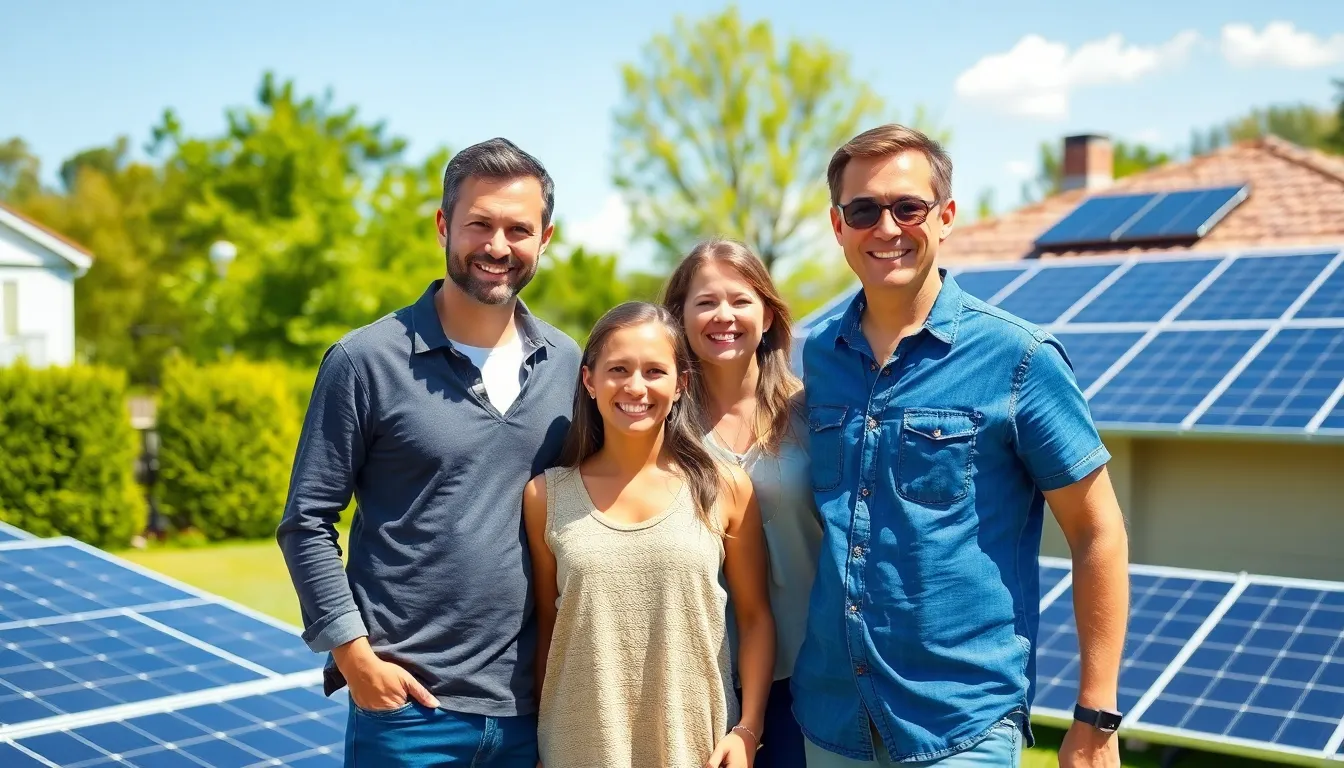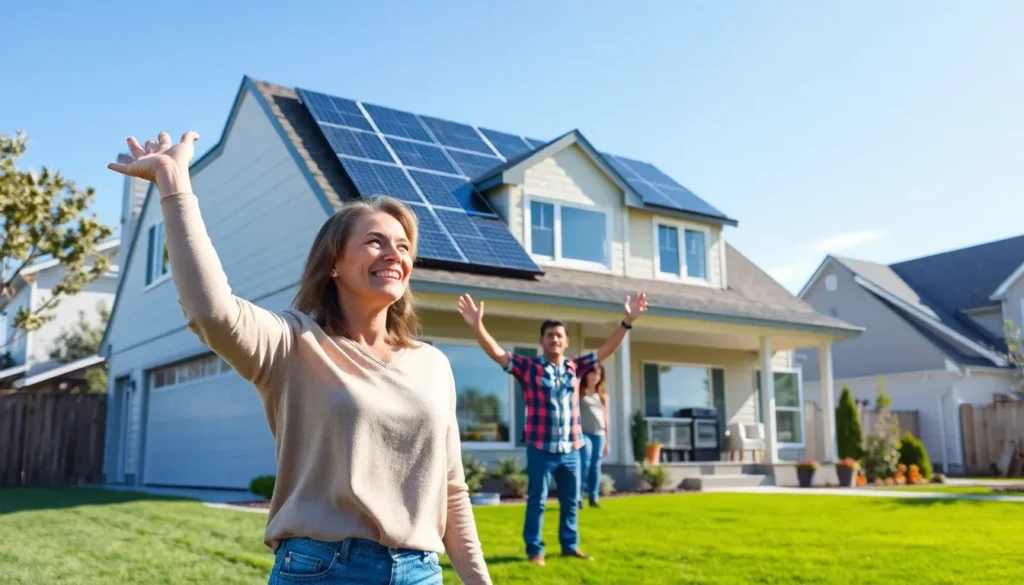Table of Contents
ToggleImagine a world where your home not only powers itself but also puts a little extra cash back in your pocket. Welcome to the realm of solar smart living, where sunshine isn’t just for picnics but for powering your daily life. With solar energy, homeowners can harness the sun’s rays, reducing their carbon footprint while enjoying the perks of lower utility bills.
Gone are the days of feeling guilty about leaving the lights on. Embracing solar smart living means embracing a lifestyle that’s as eco-friendly as it is wallet-friendly. Whether it’s installing solar panels or using smart technology to optimize energy use, the future is bright—literally! Dive into the world of solar smart living and discover how easy it is to turn those sunny days into savings.
Understanding Solar Smart Living
Solar smart living integrates renewable energy and advanced technology to enhance energy efficiency in homes. Homeowners embrace this lifestyle to lower energy costs while promoting environmental responsibility.
Definition of Solar Smart Living
Solar smart living refers to using solar energy combined with intelligent devices to manage energy consumption. This lifestyle incorporates solar panels to harness sunlight for power. Smart appliances monitor usage patterns and adjust operations for better efficiency. Innovations like solar batteries store energy for future use, ensuring optimal utility. Homeowners benefit from lower bills and reduced dependence on fossil fuels while enjoying convenience and comfort.
Importance of Sustainable Living
Sustainable living addresses pressing environmental challenges like climate change and resource depletion. Adopting eco-friendly practices, such as solar smart living, significantly lowers individual carbon footprints. Conscious energy consumption minimizes effects on ecosystems and conserves resources for future generations. Investing in renewable energy leads to less pollution and enhances long-term home value. Moreover, promoting sustainability fosters community well-being by encouraging responsible consumption among neighbors.
Benefits of Solar Smart Living

Solar smart living offers significant advantages for both the environment and the economy. By integrating solar energy with smart technology, individuals can experience a more sustainable and cost-effective lifestyle.
Environmental Impact
Choosing solar smart living reduces reliance on fossil fuels. This lifestyle minimizes carbon emissions, effectively combating climate change. When homeowners install solar panels, they contribute to a cleaner atmosphere. Renewable energy sources, like solar, decrease pollution levels, promoting healthier communities. By making this transition, individuals play a vital role in conserving natural resources and protecting ecosystems. Smart technologies enhance energy efficiency, further lowering energy consumption and environmental impact while ensuring a sustainable future.
Economic Advantages
Adopting solar smart living leads to substantial savings. Homeowners save on utility bills by generating their own electricity through solar energy. Studies suggest that households can reduce energy expenses by 50% or more. Government incentives and tax credits further add to the financial benefits, making solar technology more accessible. Increasing property values also result from energy-efficient upgrades like solar panels. Smart appliances optimize energy usage, allowing for additional cost reductions over time. This combination of savings fosters long-term financial stability for homeowners, enhancing their overall quality of life.
Technologies in Solar Smart Living
Solar smart living relies on innovative technologies to harness renewable energy and enhance energy efficiency. Two key components play critical roles in this process: solar panels and energy storage solutions.
Solar Panels
Solar panels convert sunlight into electricity, providing a clean energy source for homes. They consist of photovoltaic cells that absorb solar energy, turning it into usable power. Various types, such as monocrystalline and polycrystalline panels, offer different efficiencies. Systems can be tailored to meet specific energy needs, promoting optimal performance. Installing solar panels can reduce energy costs significantly, often by more than 50%, making them a practical investment for homeowners.
Energy Storage Solutions
Energy storage solutions, like batteries, store excess power generated by solar panels. These systems enable homeowners to use energy even during cloudy days or nighttime. Lithium-ion batteries remain the most common choice due to their efficiency and lifespan. Advanced options, such as smart inverters, enhance energy management by optimizing consumption based on usage patterns. Harnessing stored energy can lead to further savings on utility bills and increased energy independence, empowering households to utilize their renewable resources fully.
Implementing Solar Smart Living
Implementing solar smart living involves making thoughtful choices in home design and selecting suitable solar solutions to maximize energy efficiency and sustainability.
Home Design Considerations
Homeowners must prioritize design elements that enhance energy efficiency. Proper orientation of solar panels significantly impacts energy generation, as south-facing roofs receive optimal sunlight. Designing homes with energy-efficient insulation decreases heating and cooling demands. Incorporating large windows can harness natural light, reducing reliance on artificial lighting. Features like shading devices help minimize heat gain during summer months. Moreover, selecting energy-efficient appliances further complements a solar smart living approach. All these design considerations contribute to a more sustainable and energy-conscious home.
Choosing the Right Solar Solutions
Choosing solar solutions requires evaluating specific energy needs. Assessing the average energy consumption informs the selection of appropriate solar panel systems. Monocrystalline panels, known for their high efficiency, work well for limited roof space. Alternatively, polycrystalline panels offer a cost-effective option for larger installations. Energy storage systems, like lithium-ion batteries, allow for harnessing excess energy, ensuring availability during non-sunny hours. Researching local solar providers aids in finding skilled installers and maximizing available incentives. Beyond panels and batteries, integrating smart technology enhances monitoring and control of energy use, solidifying the benefits of solar smart living.
Challenges of Solar Smart Living
Solar smart living presents several challenges that potential adopters face. Understanding and addressing these hurdles is crucial for achieving a successful transition.
Initial Costs
High initial costs represent a significant barrier for many homeowners. The average cost of solar panel installation falls between $15,000 and $25,000 for a standard residential system. Additionally, expenses related to energy storage solutions can add thousands more to the total investment. Although government incentives and tax credits can ease these financial burdens, many still see the upfront outlay as prohibitive. Homeowners must weigh long-term savings against the initial expenditure. Financial planning plays a vital role in deciding whether to pursue solar smart living.
Technological Limitations
Technological limitations can hinder the effectiveness of solar smart living. Some solar panels exhibit inefficiencies in converting sunlight into electricity, typically averaging around 15% to 20% efficiency. Battery storage solutions also face challenges, such as limited capacity and high costs, which impact their viability for large-scale energy needs. Maintenance of solar panels and storage systems requires specific knowledge and may lead to additional costs. Furthermore, not all homes suit solar technology due to factors like roof orientation and shading. Homeowners should assess their property’s unique characteristics to make informed decisions about solar solutions.
Embracing solar smart living offers a pathway to a sustainable future. Homeowners can enjoy significant savings on energy bills while contributing to a healthier planet. By integrating solar technology with smart devices, they can optimize energy use and reduce their carbon footprints.
The journey toward solar smart living may present challenges, but the long-term benefits far outweigh the initial investments. With careful planning and the right choices, homeowners can create energy-efficient spaces that enhance their quality of life. As communities shift toward renewable energy solutions, the collective impact can lead to cleaner air and a more sustainable environment for generations to come.







